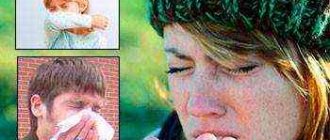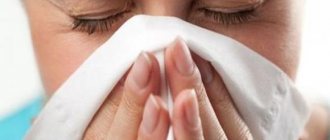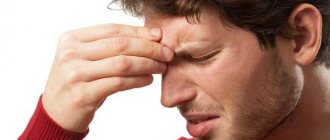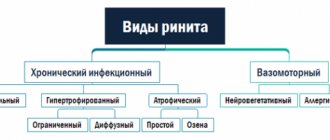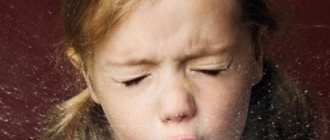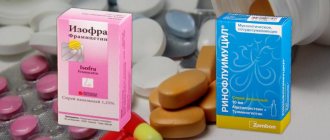Snot in a baby is the scourge of all parents. Difficulty breathing prevents the toddler from enjoying the world around him. To help the baby, you should delve as deeply as possible into the essence of the concept of what snot is and what they are like.
Why is snot flowing?
Snot is a muconasal secretion secreted by the glands of the nasal mucosa. The mucus produced coats the inside of the nose. Its function is protective.
Mucus is a very sticky substance, so bacteria and microparticles settle on it. But it also contains substances that kill pathogens.
The lining of the respiratory tract is covered with ciliated epithelium (cilia), which remove mucus along with destroyed bacteria to the outside. It is this spent “cocktail” that the child blows his nose.
If children catch a cold, develop an allergic reaction, or become hypothermic, the production of muconasal secretions rapidly increases to protect the body. Excessive mucus production is, in fact, a common runny nose.
Why does your nose run?
All mucous membranes of the body serve as a protective barrier against pathogenic microbes. The inner surface of the nose is covered with hairs and a small amount of natural mucus, on which pathogenic microorganisms settle. Together with thick yellow snot, “spent” pests are removed from the nasal sinuses. Muconasal secretion in a healthy baby is transparent and not abundant.
Intense yellow-green snot appears in a child for two reasons.
- Viral infections.
Typically, acute respiratory viral infections begin slowly, the child feels unwell, is capricious, after which clear liquid mucus begins to secrete from the nose, the child sneezes and coughs. Within a week, the discharge becomes brighter and thicker - a sign that the mucous membranes are successfully coping with viruses, processing them and removing them.
If yellow thick snot does not go away within two weeks, you should consult an otolaryngologist. The likelihood of complications (otitis, adenoiditis, sinusitis) increases if the baby complains of headache or ear pain, has elevated body temperature, lethargy, and obvious difficulty breathing. In this case, only a doctor can prescribe adequate treatment.
- Bacterial infections, the main symptom of which is rapid development. The disease begins with a sudden onset of fever, which is later joined by a runny nose and cough, and the lymph nodes become enlarged. The discharge of bright yellow snot from one or both nostrils does not always mean the presence of a bacterial infection.
The mythical threat of sinusitis. Parents often panic when they discover thick snot in their child; yellow, purulent discharge is especially frightening. In fact, sinusitis cannot occur in children under 4-5 years of age due to the immaturity of the maxillary sinuses.
What are the types of snot in children?
Initially, the secretion produced by the nasal mucosa is transparent. Then gradually it thickens and disappears. If a runny nose is caused by bacteria, the mucus changes color as the disease progresses. This is due to the fact that dead microorganisms accumulate in it. The color can vary from yellow to green, depending on the bacteria involved.
Thus, a child may have the following types of snot:
- transparent liquid;
- thick;
- yellow;
- green.
The last two types should attract special attention from parents, as they indicate the presence of bacterial or viral-bacterial rhinitis, sinusitis, and frontal sinusitis. Without the necessary help, the disease can become chronic.
Snot in children under one year of age - causes
In infants, a runny nose is an unpleasant phenomenon that causes significant concern, because the baby is not able to blow his nose on his own. What are the reasons for the appearance of snot at such a young age?
1. Physiological runny nose. The mucus released from the nose is clear and liquid in consistency. Appears during the period of teething, with excessive anxiety and changes in body temperature. Also, such snot flows during the maturation of the nasal mucosa (at 1.5-2 months). They may appear after a long walk in the fresh air.
In general, it does not pose any particular danger and is a sign of immature mucous membrane in the nose, which reacts with increased secretion in response to any irritant. Right down to ordinary house dust, which a toddler could inhale while hiding behind a closet.
The biggest disadvantage: such sputum, having thickened, prevents the baby from sleeping or sucking on the mother’s breast.
2. A cold in a baby is caused by an infection (virus or bacteria). The mucus becomes thick over time. This type of snot is dangerous because it can provoke a much more serious illness (bronchitis, pneumonia, otitis media).
Treatment options
Caring for a baby under one year old with a runny nose consists of the following:
— moisturizing the nasopharynx with saline solution (saline solution) 3-4 times a day to prevent infection from entering the child’s body;
— cleansing the nasal passages of accumulated mucus (using cotton wool turunds, a small rubber bulb or an aspirator);
— the use of oil massage as a prevention of physiological runny nose: just apply a drop of crumbs of oil (peach, sea buckthorn, etc.) to the wings of the nose and massage gently.
- reducing the baby’s temperature using compresses, taking an antipyretic (paracetamol-based);
— providing plenty of drinking water;
- taking vasoconstrictors according to the regimen prescribed by the pediatrician;
- treatment with antibiotics in the absence of positive dynamics is also prescribed by the doctor.
Why does yellow snot appear?
The reasons for the appearance of yellowish nasal discharge can be different. In this case, the shade and consistency of the mucus may differ. Yellow nasal discharge in a child may occur for the following reasons:
The onset of the recovery period. This phenomenon can occur if the child has previously suffered an acute respiratory infection. At first, the snot is liquid and almost transparent. And at the final stage they darken, become more viscous and acquire a yellowish tint. Typically, such discharge easily comes out of the nose, and breathing is restored after the child blows his nose.- Chronic inflammatory process in the nasal area. This may be a complication of untreated ARVI or influenza, so in childhood it is recommended to treat any pathologies under the supervision of a doctor. If signs of respiratory disease do not subside within 10 days, parents should be wary. Often yellow snot appears after previous sinusitis, otitis or adenoiditis. If they contain reddish-brown inclusions, this may indicate the presence of a purulent process in the nose. Sinusitis is very often the cause of this type of discharge.
- Allergy. Yellowish liquid discharge without any impurities may indicate an allergic etiology of its occurrence. They appear directly when the respiratory tract is exposed to an allergen. But as soon as this stops, the snot will disappear. Rarely, the mucus may be white or bright yellow. Such discharge cannot be thick.
- Injuries to the nasal cavity. If a child has suffered a nasal fracture, this pathology must be treated immediately. Sometimes an inflammatory process begins, and purulent exudate accumulates in the nose, which will eventually burst. In this case, yellow-green discharge will occur. They may have an unpleasant pus-like odor and are thick and viscous.
An infant's nasal discharge may be normal. The small organism gets rid of mucus that entered the respiratory tract during fetal development. But it is still recommended to consult a pediatrician.
After all, only a doctor can determine the exact cause of such a symptom. To make an accurate diagnosis, additional examinations may be required - x-rays or ultrasound. Self-medication can be dangerous to the baby’s health and lead to various complications.
Green snot in a child - reasons
Abundant green snot in a baby, especially with a concomitant rise in temperature to 37-38°C, is usually caused by an inflammatory process in the paranasal sinuses, which can be bacterial in nature.
If the upper two, located on the sides of the nose, are affected (they become inflamed more often than the other pair), then we are talking about sinusitis, or sinusitis.
If the sinuses located in the lower part of the forehead are affected, frontal sinusitis is suspected.
An additional sign of such a preliminary diagnosis can be very noticeable pain in these areas of the nose, causing discomfort.
Green snot in a child - methods of treatment
All of these pathologies must be immediately diagnosed by a specialist (ENT doctor or pediatrician). These diseases should not be treated without the attention of a doctor, because they can develop into a chronic form. Self-medication can also be fraught with complications, so the prescription should be made exclusively by a doctor.
Most often, treatment begins with nasal drops and rinses. This procedure should be performed correctly so as not to further harm the baby. Considering that a baby cannot blow out green mucus, you need to purchase an aspirator at the pharmacy - a device for sucking out thickened secretions from the nasal cavity.
Then you will need saline solution (sold) and a syringe (remove the needle). With the child lying on one side, 0.5 cc of rinsing liquid is poured into the upper nostril. Then the baby should be turned over onto the other side and the solution in the same volume should be poured into the second hole.
After rinsing the baby’s nose, it should be instilled with vasoconstrictors (as prescribed by the doctor). This procedure is carried out similarly to washing. It should be performed carefully, making sure that the drops get on the mucous membrane, otherwise the desired effect will not be achieved.
Complex treatment also includes physiotherapeutic procedures (local heating of the affected sinuses and ultraviolet irradiation), taking antibacterial agents. In case of a severe situation, the doctor may prescribe a course of antibiotics and vitamin complexes to support the baby’s weakened body.
Transparent snot in a child - causes
The usual transparent nasal discharge, which hurts my mother's heart, most often appears in children of kindergarten age. It would seem that as soon as the child was treated, after a couple of days of visiting the group, he again felt unwell. What are the reasons for the appearance of such mucus? This needs to be clarified, because the regimen and duration of treatment will depend on this knowledge.
1. Allergic reaction. We can talk about it if a runny nose most often appears in the spring (blooming trees, plants) or in the summer (blooming and pollen of weeds). Most often, nasal congestion and clear snot are accompanied by other symptoms: increased lacrimation, redness of the eyes, redness on the body or even rash, skin itching. Another sign of an allergic rhinitis in a child is frequent sneezing. In this case, parents should find out as early as possible which factor causes such a reaction.
2. ORZ, ORV. Viruses are one of the most common causes of clear snot in children of any age. A runny nose develops against a background of increased body temperature, sore throat, frequent sneezing, and headache.
When to see a doctor
It’s definitely worth showing sick babies under one year of age to the pediatrician. In the case of a small child, home treatment can only worsen the situation and cause complications for the whole body, because any infection weakens the immune system.
If your child is old enough to be treated at home without fear, make an appointment with a doctor if a runny nose with yellow and greenish discharge does not go away for more than one week.
You should be especially wary if the symptoms of the disease do not subside over time, but, on the contrary, intensify. If you show your baby to an otolaryngologist on time, you can relieve him of breathing problems without consequences.
Transparent snot in a child - methods of treatment
First of all, you need to consult an otolaryngologist who will prescribe treatment based on the etiology. At the same time it is necessary:
- constantly cleansing the baby’s nose of mucus to make breathing easier.
— ensuring humidity in the room;
- in case of viral etiology, the sick toddler should be provided with bed rest and plenty of fluids.
Inhalation of essential oils that have an antiseptic effect - mint, fir, eucalyptus, lavender - can help overcome a runny nose, but to achieve the effect, the child must breathe them regularly (2-3 times a day). The solution is to use a special product with essential oils, for example, a patch - “Breathe” inhaler. It is convenient to attach it to the child’s clothing in the chest area, and for 8 hours essential oils will evaporate from it, clearing the airways of pathogenic bacteria and viruses, making breathing easier and eliminating nasal congestion. This method of use does not dry out the mucous membranes and is not addictive.
There is no need to use vasoconstrictor medications, since clear snot indicates that the child’s healthy body is fighting the disease.
Treatment
If the cause of the appearance of yellow snot is determined not to be recovery, but a worsening of the cold, the doctor must determine what kind of inflammation provokes this discharge in the child. For example, there are viral, bacterial and fungal rhinitis, bacterial otitis, inflammation of the adenoids.
There are different treatment methods - both traditional and medicinal. It is impossible to say for sure which of them are more effective and which are weaker, because each organism is individual and what did not help one baby can cure another without the use of radical methods.
Did you know? It is impossible to get rid of a cold, you can only wait it out. Therefore, Honore de Balzac’s personal physician did not deceive his eminent patient when he caught a cold, but prescribed him “four to seven handkerchiefs” a day. Not the most effective treatment, but much more pleasant than the methods of Hippocrates. He recommended getting rid of a runny nose using bloodletting, which was popular in those days.
Medication methods
First of all, ENT doctors prescribe rinsing the nose and sinuses. In most cases, it helps - it flushes out the remnants of a bacterial or viral infection, accumulations of mucus that begin to fester, and makes breathing easier.
Several treatments are required to completely clear the sinuses and ensure that the disease does not return in the near future. Rinse your nose with saline solutions either at home or (if the problem is advanced) in a hospital.
To rinse your baby’s nose at home, you can use special nasal sprays and rinsing kits, because only a doctor or a trained parent can rinse with a solution from a syringe.
When an otolaryngologist discovers that a viral or bacterial infection that provokes the appearance of yellow snot in children develops quickly and rinsing with saline solution is not enough, he prescribes a course of antiseptics for treatment that can destroy pathogenic microflora.
All of them are freely available and available without a doctor’s prescription, although it is still necessary to consult first. You've probably heard such names as furatsilin, miramistin, "Chlorophyllipt".
They are introduced into the nasal passages in the form of a spray or cream, and the sinuses are washed with solutions made on their basis. Such remedies can eliminate even severe infections.
The drug "Rinofluimucil" is used in addition to the main treatment in order to reduce the viscosity of secretions and facilitate their leaching.
If the infection continues to develop even after washing with antiseptics, local antibiotic drugs are prescribed - Bioparox, Isofra, Sumamed.
These medications are taken in courses that, depending on the strength of the antibiotic, last from five to ten days. Antibiotics are rarely prescribed to newborns and babies under one year of age, and if they are prescribed, it is only in the form of a suspension for internal use.
Important! If a doctor has diagnosed your child with sinusitis, rinse his nose as often as possible. Ask your doctor to teach you the correct technique and rinse at least seven times a day - this is the only way the infection will go away.
ethnoscience
It is possible to treat a baby with drugs of natural origin only in two cases - if he is not prone to allergies, and if he is at the stage of recovery.
All other treatment for a runny nose with yellow snot must be carried out strictly under medical supervision and with the help of proven medications, otherwise complications may develop in a child who is at a progressive stage of an infectious disease.
Decoctions of medicinal flowers have proven themselves very good in the fight against yellow snot. Surely you know about the antibacterial properties of chamomile, calendula, sage, and string.
The drugs “Bebicalm”, “Amoxicillin”, “Enterofuril”, “Protargol”, “Tonsilgon”, “Linex”, as well as echinacea and licorice root have an antibacterial effect.
Decoctions of these herbs have a very mild effect, gently moisturize the mucous membranes, thin and remove thick secretions and normalize the microflora of the nasal passages.
The easiest way to prepare the medicine is to infuse a tablespoon of any of the above medicinal herbs in a glass of boiling water, and leave this infusion covered for half an hour.
After cooling, you will need to strain it through cheesecloth and rinse your sinuses in the same way as with saline solution. After rinsing, ask your baby to thoroughly blow his nose so that liquefied mucus and remaining fluid come out of the nasal passages.
St. John's wort and linden blossom also have a good effect on a sick baby - you can drink their decoctions and make compresses on the bridge of the nose and forehead.
Did you know? Aloe juice is considered one of the best folk remedies for the treatment of runny nose. The wonderful healing properties of aloe have been known to people since the 6th century. It was first mentioned in his works by Aristotle, who once advised Alexander the Great to capture the island of Socotra in the Indian Ocean so that his people would have unlimited access to this amazing plant.
Aloe, a faithful home doctor, produces juice with pronounced antibacterial properties. It can be instilled directly into the nose and mixed with a solution for rinsing - it does not burn the mucous membranes, the only thing is that it can give a bitter taste in the larynx.
Propolis can be used for oil washes; it kills all pathogenic microflora, but is prohibited for use on infants.
Eucalyptus oil also has a bactericidal effect. Dropping it into the nose will cause significant discomfort to the baby, so limit yourself to rinsing with the oil in the form of a suspension or leave the aromatic pendant next to the pillow on which the child sleeps.
Yellow snot in a child - causes
Many pediatricians believe that snot alone cannot tell us much. Any runny nose that begins with clear nasal discharge progresses to a stage where it thickens, becomes yellowish in color, and then disappears. This is due to the fact that white blood cells in the mucus kill harmful microorganisms and dead bacteria, accumulating and turning the secretion yellowish.
But one should distinguish between the situation when these snot appear after several days of a runny nose, as a sign of recovery, and when such a symptom lasts for several weeks. In the latter case, most likely, we will be talking about a more serious disease - sinusitis, rhinitis, chronic sinusitis. In this case, the cause of yellow snot is most often bacteria. Sometimes even allergic reactions are involved in the etiology of the disease. To avoid such complications, you should bring your child to an ENT doctor as soon as unusually colored sputum begins to appear with a prolonged runny nose. You may also need to consult an allergist-immunologist.
Yellow snot in a child - treatment methods
The first thing they start doing if a child has yellow snot is rinsing the nose. To do this, you can use a pharmacy saline solution. Even more effective are special products based on sea water. These are drugs such as Aquamaris, Salin.
If you don’t have anything at hand, then you can make a saline solution for rinsing your nose at home: dilute 1 teaspoon of ordinary table salt with 1 glass of boiled water. The main thing is to carry out the washing procedure correctly so that there are no consequences in the form of otitis media.
For complete treatment, the otolaryngologist prescribes drops. All children are unique, the etiology of the disease in each case may be different, therefore the remedies may be different: Derinat, Dolphin, Dioxidin and others. Moreover, they are not analogues; some of them contain antibiotics. Naturally, they must be used with caution and after consultation. As additional remedies, special ointments and tablets appropriate for the disease can be used.
Folk remedies for treating yellow and thick snot
For the treatment of a prolonged runny nose, traditional medicine offers many recipes; we will consider the most popular ones now.
Rinse the nose with herbal infusions
The herbs most often used for herbal washes are:
- chamomile;
- St. John's wort;
- sage;
- calendula.
Herbs can be used both in collections and separately. For 10 grams of herb you will need 200 ml of boiling water. Infuse the herbs for 30 minutes, wrapping the container in a towel. Rinse using a pipette, filling its entire volume.
Kalanchoe juice drops
Kalanchoe juice is an effective remedy that helps quickly get rid of thick mucus in the nose and improve the child’s condition. To do this, you need to cut a small leaf of this plant, wash it and squeeze out the juice. Fresh juice is instilled two drops into each nasal passage. Continue treatment until the nose is completely cleansed, usually three days is enough. Kalanchoe juice can be dripped 1-2 times a day.
The effect of Kalanchoe juice a few minutes after instillation
We discussed treatment with Kalanchoe in more detail in this article [Kalanchoe juice for a runny nose].
Sea salt solution
Dissolve a teaspoon of salt in a liter of warm water. Give your child rinses four times a day, and be sure to do this procedure five minutes before instilling all the medicinal drops.
Warming up with boiled eggs
If the child does not have a fever, then with yellow snot, you can warm it up with boiled eggs. Place two eggs along the bridge of your nose and warm your nose for no more than five minutes. The eggs should not be hot.
Warming up with salt
Heat a small amount of salt in a frying pan. Place it in small bags made of natural fabric. When warm, apply to the bridge of your nose. Continue the procedure for 5–7 minutes.
Beet juice drops
Place two drops of fresh beetroot juice into each nasal passage of your child. Continue using drops in your nose three times a day until the condition of the mucous membrane improves. If the juice causes burning, itching or other unpleasant sensations, dilute it with water in a 1:1 ratio.

